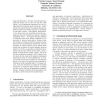Free Online Productivity Tools
i2Speak
i2Symbol
i2OCR
iTex2Img
iWeb2Print
iWeb2Shot
i2Type
iPdf2Split
iPdf2Merge
i2Bopomofo
i2Arabic
i2Style
i2Image
i2PDF
iLatex2Rtf
Sci2ools
IJCAI
1997
1997
Object Identification in a Bayesian Context
Object identification—the task of deciding that two observed objects are in fact one and the same object—is a fundamental requirement for any situated agent that reasons about individuals. Object identity, as represented by the equality operator between two terms in predicate calculus, is essentially a first-order concept. Raw sensory observations, on the other hand, are essentially propositional— especially when formulated as evidence in standard probability theory. This paper describes patterns of reasoning that allow identity sentences to be grounded in sensory observations, thereby bridging the gap. We begin by defining a physical event space over which probabilities are defined. We then introduce an identity criterion, which selects those events that correspond to identity between observed objects. From this, we are able to compute the probability that any two objects are the same, given a stream of observations of many objects. We show that the appearance probability, whic...
| Added | 01 Nov 2010 |
| Updated | 01 Nov 2010 |
| Type | Conference |
| Year | 1997 |
| Where | IJCAI |
| Authors | Timothy Huang, Stuart J. Russell |
Comments (0)

